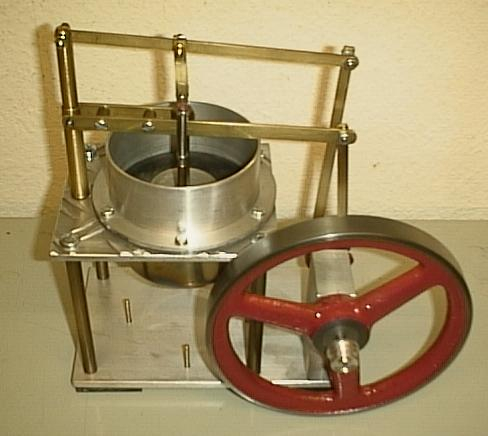|
Manson-Guise Engine
A Manson-Guise engine is a simplified, albeit less powerful version of a Manson engine. It is a type of hot air engine, converting a temperature difference into motion. There is a hot side and a cold side to the engine. Providing there is a large enough temperature difference between the two sides the engine will run. The Manson-Guise engine is probably the simplest type of hot air engines having only a single con-rod, with a displacer piston and power piston that move at the same time. Manson-Guise engines, like Manson engines and beta Stirling engines, can run bidirectionally. Similarities to Stirling engines Manson-Guise engines share some similarities with Stirling engine A Stirling engine is a heat engine that is operated by the cyclic compression and expansion of air or other gas (the '' working fluid'') between different temperatures, resulting in a net conversion of heat energy to mechanical work. More spe ...s but with two major differences. Firstly with a Sti ... [...More Info...] [...Related Items...] OR: [Wikipedia] [Google] [Baidu] |
Manson Engine
The Manson engine is a hot air engine that was first described by A. D. Manson in the March 1952 issue of ''Newnes Practical Mechanics''-Magazines. Manson engines can be started in either direction (clockwise or anti-clockwise). It has a stepped piston. The front part acts as a displacer and the back part acts as a work piston (the displacer and the work piston move as a single component). The engine only requires three moving parts: piston, piston rod, and crank. The engine is single- and double-acting cylinders, double acting, using both the expansion of the warmed air and atmospheric pressure overcoming the reducing pressure of the cooling air to do work. The engine currently has no commercial or practical applications. The engines are built mainly as desk toys, physics demonstrations, and novelties. Functioning mechanism * Phase 1 (cooling down the work medium, suction stroke) ** when the Piston is moved toward the heat source, the hot gas inside the engine is moved to the ... [...More Info...] [...Related Items...] OR: [Wikipedia] [Google] [Baidu] |
Hot Air Engine
A hot air engine (historically called an air engine or caloric engine) is any heat engine that uses the expansion and contraction of air under the influence of a temperature change to convert thermal energy into mechanical work. These engines may be based on a number of thermodynamic cycles encompassing both open cycle devices such as those of Sir George Cayley and John Ericsson and the closed cycle engine of Robert Stirling. Hot air engines are distinct from the better known internal combustion based engine and steam engine. In a typical implementation, air is repeatedly heated and cooled in a cylinder and the resulting expansion and contraction are used to move a piston and produce useful mechanical work. Definition The term "hot air engine" specifically excludes any engine performing a thermodynamic cycle in which the working fluid undergoes a phase transition, such as the Rankine cycle. Also excluded are conventional internal combustion engines, in which heat is added ... [...More Info...] [...Related Items...] OR: [Wikipedia] [Google] [Baidu] |
Stirling Engine
A Stirling engine is a heat engine that is operated by the cyclic compression and expansion of air or other gas (the '' working fluid'') between different temperatures, resulting in a net conversion of heat energy to mechanical work. More specifically, the Stirling engine is a closed-cycle regenerative heat engine with a permanent gaseous working fluid. ''Closed-cycle'', in this context, means a thermodynamic system in which the working fluid is permanently contained within the system, and ''regenerative'' describes the use of a specific type of internal heat exchanger and thermal store, known as the ''regenerator''. Strictly speaking, the inclusion of the regenerator is what differentiates a Stirling engine from other closed-cycle hot air engines. In the Stirling engine, a gas is heated and expanded by energy supplied from outside the engine's interior space (cylinder). It is then shunted to a different location within the engine, where it is cooled and compressed. A pisto ... [...More Info...] [...Related Items...] OR: [Wikipedia] [Google] [Baidu] |
Kickstarter
Kickstarter is an American public benefit corporation based in Brooklyn, New York, that maintains a global crowdfunding platform focused on creativity. The company's stated mission is to "help bring creative projects to life". As of July 2021, Kickstarter has received $6.6 billion in pledges from 21 million backers to fund 222,000 projects, such as films, music, stage shows, comics, journalism, video games, board games, technology, publishing, and food-related projects. People who back Kickstarter projects are offered tangible rewards or experiences in exchange for their pledges. This model traces its roots to subscription model of arts patronage, where artists would go directly to their audiences to fund their work. History Kickstarter launched on April 28, 2009, by Perry Chen, Yancey Strickler, and Charles Adler. '' The New York Times'' called Kickstarter "the people's NEA". '' Time'' named it one of the "Best Inventions of 2010" and "Best Websites of 2011". Kickstarter r ... [...More Info...] [...Related Items...] OR: [Wikipedia] [Google] [Baidu] |



.jpg)